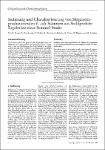Isolierung und Charakterisierung von Shigatoxin-produzierendenE. coli-Stämmen aus Stuhlproben: Ergebnisse einer Sentinel-Studie
Prager, Rita
Reissbrodt, Rolf
Holler, H.
Gericke, B.
Aleksic, S.
Claus, Hermann
Wagner, H.
Tschäpe, Helmut
Zur Erfassung der Häufigkeit und des Typenspektrums von Shigatoxin-produzierendenE. coli-Stämmen (EHEC-Bakterien) sowie zur Evaluierung der Praktikabilität, Spezifität und Sensitivität eines Verfahrens zur Diagnostik von EHEC wurde eine Sentinel-Studie im Einzugsbereich (1,1 Mio. Einwohner) eines privat niedergelassenen Untersuchungslabors durchgeführt. Von 3835 untersuchten Durchfallstühlen konnten in ca. 3 % EHEC-Bakterien nachgewiesen werden, die zu einem ungewöhnlich breiten Spektrum von Serovaren und Klonen mit sehr verschiedenen Virulenzfaktoren gehörten. So ließen sich nur ca. 10 % der isolierten EHEC-Stämme als O157 identifizieren, aber ebenso häufig auch O103, O26, O8 oder Ont-Stämme. Ein kombiniertes Verfahren von bestimmten kulturellen und molekularen Methoden erwies sich als praktikabel für die Routinediagnostik unter den zeitlichen und ökonomischen Anforderungen und Bedingungen von privat niedergelassenen Laboratorien. In order to record the incidence and clonal types of shigatoxin-producing E. coli of human origin (EHEC) and to evaluate the feasibility, sensitivity and specificity of a protocol for screening and isolation of EHEC under conditions clinical stool diagnostics a pilot study (Sentinel-study) was carried out with private clinical laboratory (covering 1.1 Mio. inhabitants). 3 % EHEC bacteria were detected among 3835 stool samples investigated from patients suffering with watery and bloody diarrhoea. These isolates belong to a broad range of serovars and clones with a spectrum of various virulence factors. Thus, about 10 % of the isolates have been identified as E. coli O157:H7/-, only, but with the same frequency E. coli O103:H2, O26:H11/-, O8:H or Ont. The protocol of combined bacterial enrichment and molecular methods turned out to be valuable and feasible under conditions and economic requests of private diagnostic laboratories covering ca. 85 % of primary diagnostics.
No license information

